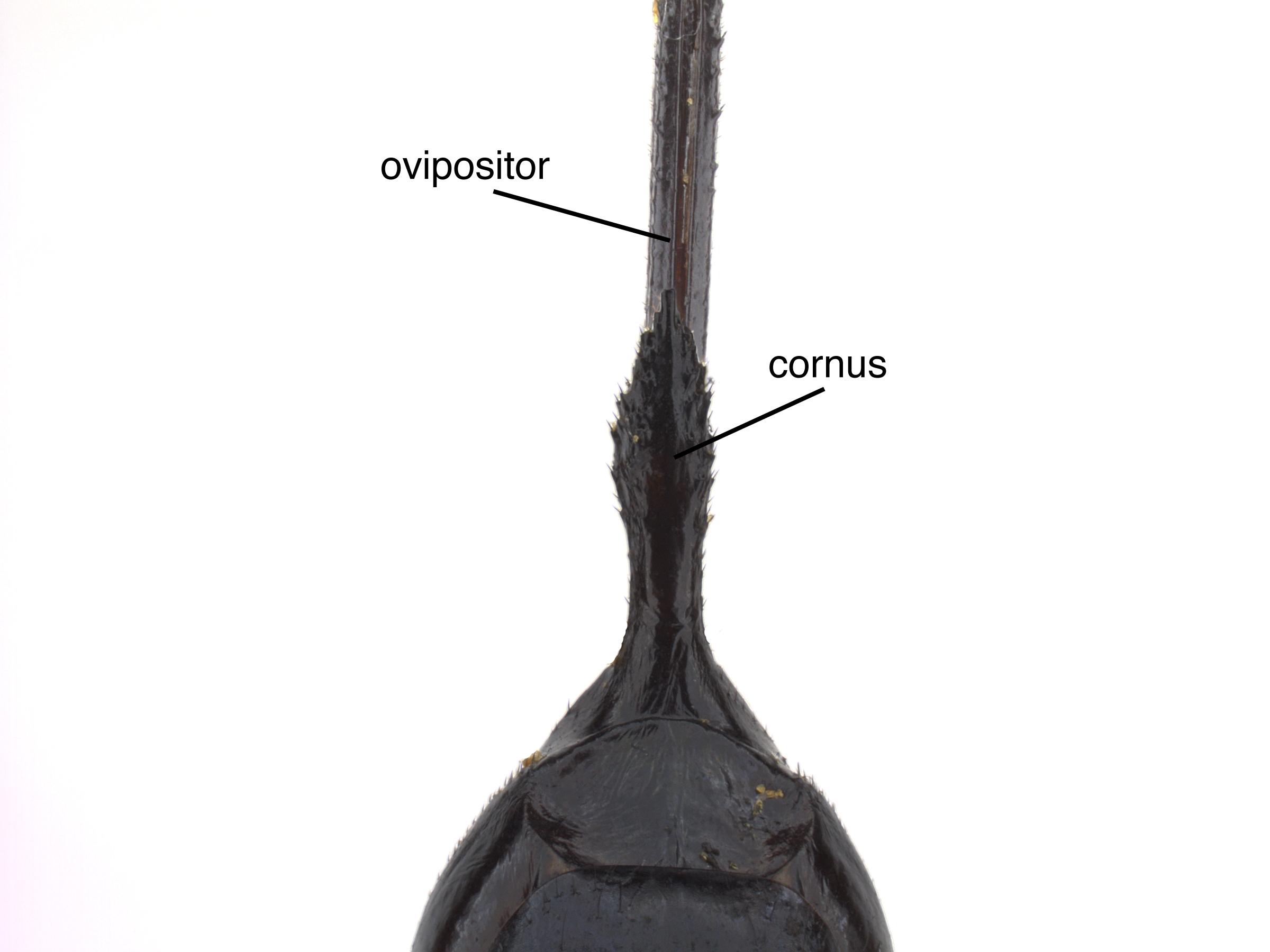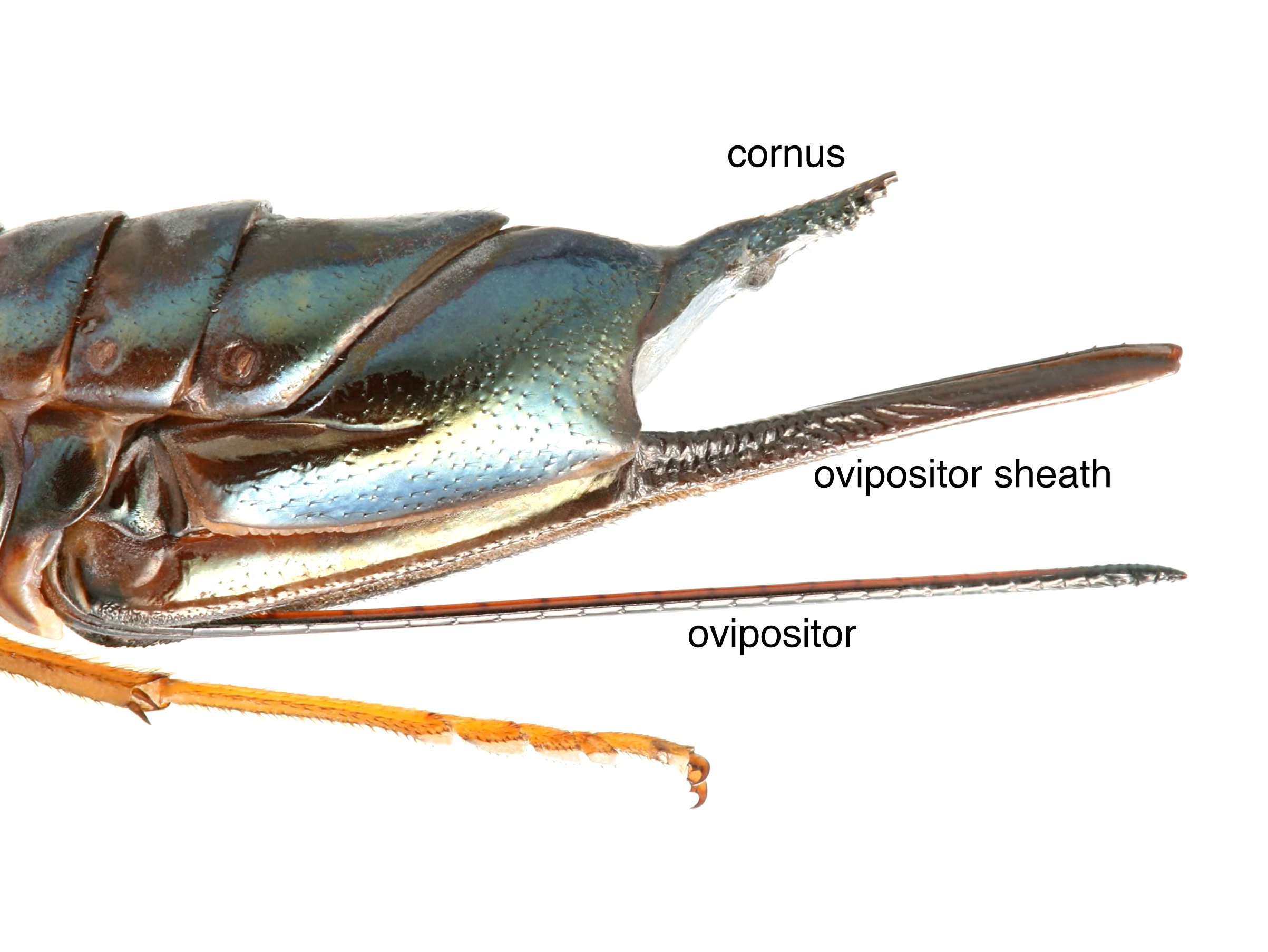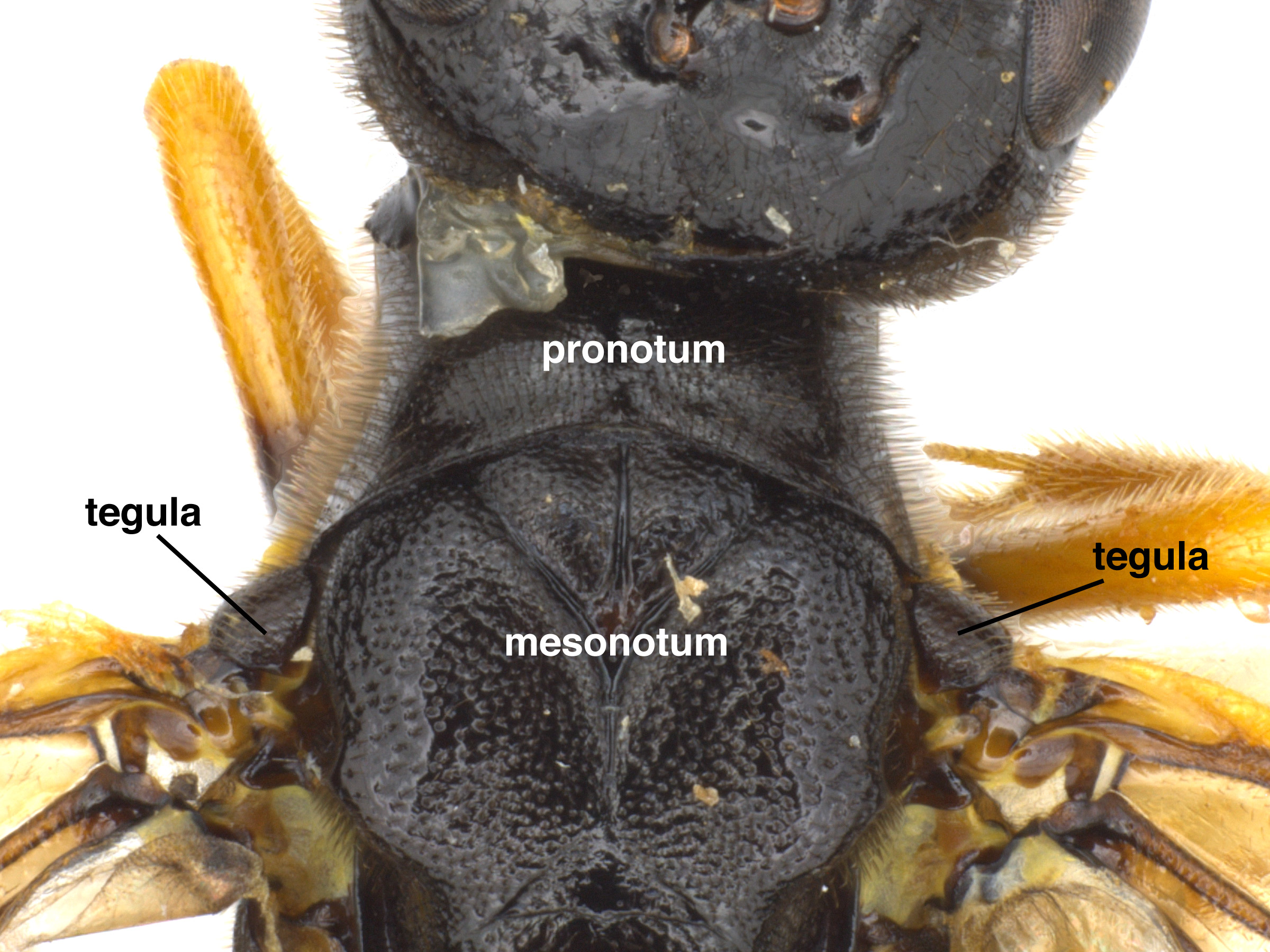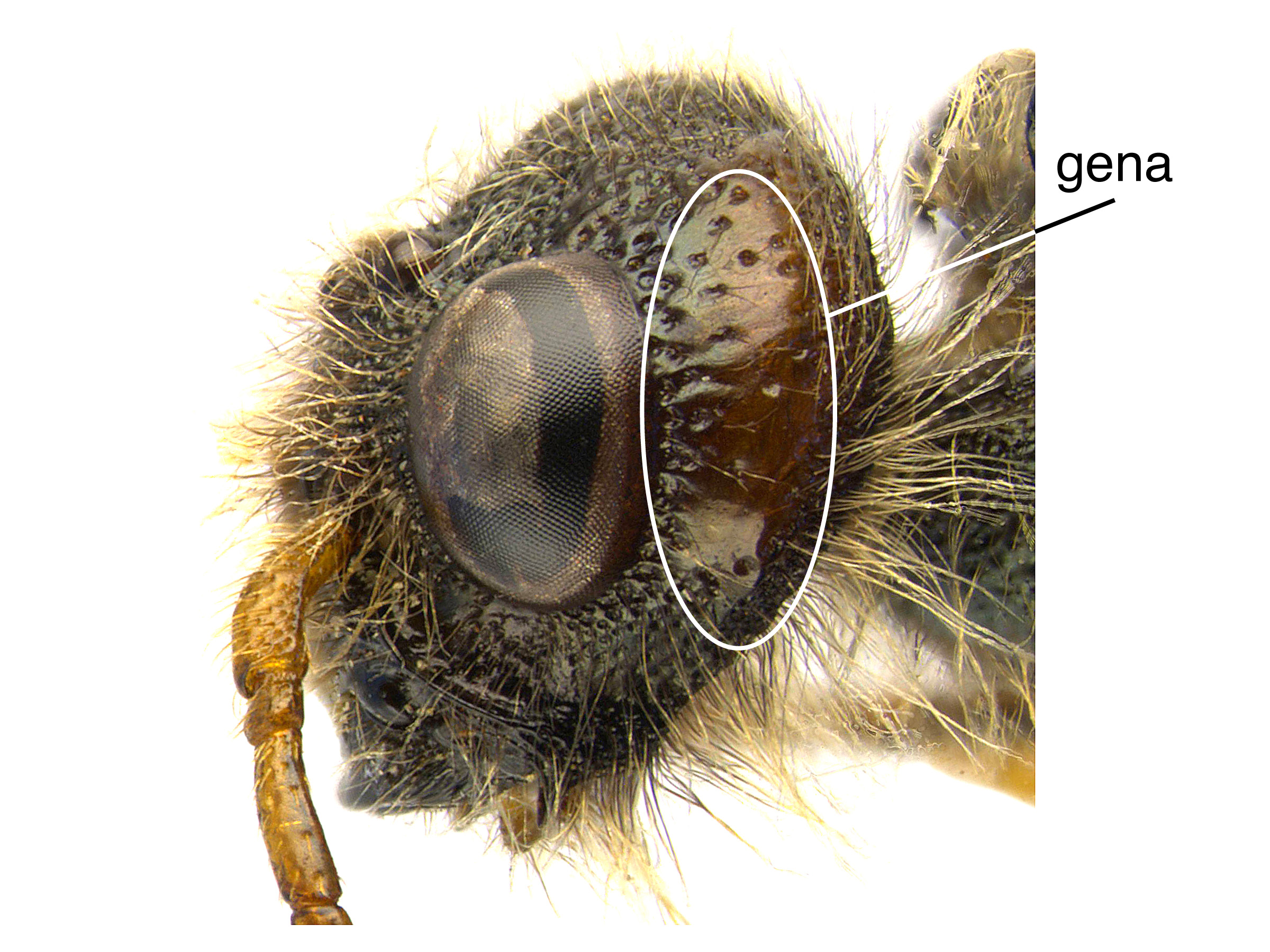Family: Siricidae
Family common name: horntails
Subfamily: Tremecinae
Genus: Tremex Jurine, 1807
Subgenera: none
The Siricidae are called “horntails” because of the cornuscornus:
a pointed horn-like process on the apical end of the abdomen in Siricidae sawflies; on tergite 10 in females, sternite 9 in males
 , a short spine at the apexapex:
, a short spine at the apexapex:
the end or most distal area of any structure
of the abdomenabdomen:
the third and last segment of an insect's body; in sawflies this is usually made up of 11 segments (segments 9 and 10 often fused) . Females in the family also possess a long, conspicuous ovipositorovipositor:
. Females in the family also possess a long, conspicuous ovipositorovipositor:
the female organ that deposits eggs and is used to drill into plant tissue, located at the apex of the abdomen, made up of the lance and lancet
 . This is often mistaken for a stinger, but it is harmless to animals and used for drilling into wood. This habit has inspired the other common name of this family: “woodwasps” (Klass 1974Klass 1974:
. This is often mistaken for a stinger, but it is harmless to animals and used for drilling into wood. This habit has inspired the other common name of this family: “woodwasps” (Klass 1974Klass 1974:
Klass C. 1974. Horntails or wood wasps. Insect Diagnotic Laboratory Cornell University.).
Horntails of the genus Tremex are large and slender with a cylindrical abdomenabdomen:
the third and last segment of an insect's body; in sawflies this is usually made up of 11 segments (segments 9 and 10 often fused) . The only North American species, Tremex columba, has at least four color morphs throughout its range, comprising combinations of brown, reddish-brown, and yellow. Females are generally larger than males, but because body size is highly variable within species, sexes are best distinguished by presence or absence of the long ovipositorovipositor:
. The only North American species, Tremex columba, has at least four color morphs throughout its range, comprising combinations of brown, reddish-brown, and yellow. Females are generally larger than males, but because body size is highly variable within species, sexes are best distinguished by presence or absence of the long ovipositorovipositor:
the female organ that deposits eggs and is used to drill into plant tissue, located at the apex of the abdomen, made up of the lance and lancet
 (Cranshaw 2013Cranshaw 2013:
(Cranshaw 2013Cranshaw 2013:
Cranshaw W. 2013. Pigeon tremex horntail and the giant ichneumon wasp fact sheet no. 5.604. Colorado State University Extension Insect Series: Home and Garden.).
Worldwide, there are 33 described species with highest diversity in East Asia. Only one species occurs in, and is endemicendemic:
both native and unique to a particular region
to, North America (Schiff et al. 2012Schiff et al. 2012:
Schiff NM, Goulet H, Smith DR, Boudreault C, Wilson AD, and Scheffler BE. 2012. Siricidae (Hymenoptera: Symphyta: Siricoidea) of the Western Hemisphere. Canadian Journal of Arthropod Identification 21: 1-305.).
A key to North American species of Tremex is included in Schiff et al. 2012Schiff et al. 2012:
Schiff NM, Goulet H, Smith DR, Boudreault C, Wilson AD, and Scheffler BE. 2012. Siricidae (Hymenoptera: Symphyta: Siricoidea) of the Western Hemisphere. Canadian Journal of Arthropod Identification 21: 1-305..
 (Schiff et al. 2012Schiff et al. 2012:
(Schiff et al. 2012Schiff et al. 2012: 10 of the female, sternumsternum:
10 of the female, sternumsternum: 9 of the male, known as the cornuscornus:
9 of the male, known as the cornuscornus: (Schiff et al. 2012Schiff et al. 2012:
(Schiff et al. 2012Schiff et al. 2012: spurspur:
spurspur:Tremex can be confused with other Siricidae, especially Eriotremex, because of the similar coloration. They can be distinguished from other genera in the family by the single tibial spurspur:
spine, usually on a leg segment
, the lack of a ridge on the genagena:
the area of the head between the compound eye and clypeus; also called the cheek
 behind the eye, the number of antennal segments, and a short ovipositorovipositor:
behind the eye, the number of antennal segments, and a short ovipositorovipositor:
the female organ that deposits eggs and is used to drill into plant tissue, located at the apex of the abdomen, made up of the lance and lancet
 . They can be distinguished from Eriotremex formosanus in North America by the lack of long golden-yellow hairs on the body (Schiff et al. 2012Schiff et al. 2012:
. They can be distinguished from Eriotremex formosanus in North America by the lack of long golden-yellow hairs on the body (Schiff et al. 2012Schiff et al. 2012:
Schiff NM, Goulet H, Smith DR, Boudreault C, Wilson AD, and Scheffler BE. 2012. Siricidae (Hymenoptera: Symphyta: Siricoidea) of the Western Hemisphere. Canadian Journal of Arthropod Identification 21: 1-305.).
Siricidae are commonly intercepted in wood packing materials at ports of entry. The potential of larval stages to persist and develop for multiple years increases the potential of successful establishment from improperly treated or disposed of wood material.
Tremex fuscicornis is an introduced species to Australia and South America (Schiff et al. 2012Schiff et al. 2012:
Schiff NM, Goulet H, Smith DR, Boudreault C, Wilson AD, and Scheffler BE. 2012. Siricidae (Hymenoptera: Symphyta: Siricoidea) of the Western Hemisphere. Canadian Journal of Arthropod Identification 21: 1-305.). In Chile for example, established populations were discovered in 2000, and there has been significant damage recorded on walnut, poplar, maple, and willow trees (Parra et al. 2007Parra et al. 2007:
Parra Sanhueza P, Gonzaacute;lez Gonzaacute;lez MV, Salinas R, and Aguirre S. 2007. D. A. Estrategia de manejo integrado de Tremex fuscicornis (Fabr.) en Chile. Instituto Forestal. Sanitario Forestal No. 5.). Though not yet established in North America, the generalist feeding behavior targeting several common trees and documented invasions makes this species a potential threat (USDA 1985USDA 1985:
U.S. Department of Agriculture (USDA) Forest Service. 1985. Insects of Eastern Forests. Miscellaneous Publication 1426. Washington DC, USDA-FS. 608 pp.).
In North America, Tremex species have been documented using a variety of host trees in several families (Schiff et al. 2012Schiff et al. 2012:
Schiff NM, Goulet H, Smith DR, Boudreault C, Wilson AD, and Scheffler BE. 2012. Siricidae (Hymenoptera: Symphyta: Siricoidea) of the Western Hemisphere. Canadian Journal of Arthropod Identification 21: 1-305.). Among them are Acer spp. (maple), Carpinus sp. (hornbeam), Robinia spp. (black locust), Castanea dentata (American chestnut), Fagus spp. (beech), Quercus sp. (oak), Carya spp. (hickory), Juglans cinerea (white walnut), Nyssa sylvatica (tupelo), Fraxinus sp. (ash), Platanus occidentalis (American sycamore), Malus sp. (apple), Pyrus sp. (pear), Populus spp. (cottonwood), Salix sp. (willow), Celtis spp. (hackberry), and Ulmus spp. (elm) (Schiff et al. 2012Schiff et al. 2012:
Schiff NM, Goulet H, Smith DR, Boudreault C, Wilson AD, and Scheffler BE. 2012. Siricidae (Hymenoptera: Symphyta: Siricoidea) of the Western Hemisphere. Canadian Journal of Arthropod Identification 21: 1-305.).
Female Tremex harbor symbiotic basidiomycete fungus in abdominal glands called mycangia. During oviposition, the site is inoculated with the fungus, which begins to decompose the surrounding wood. LarvaeLarva:
the immature stage of holometabolous insects
 feed on the fungus, and in the process bore galleries through the wood. The fungal symbiont for T. columba, T. fuscicornis, and T. longicollis is the species Cerrena unicolor. Females reserve mucus in additional abdominal glands, but the function of these reservoirs is not well understood; the excreted mucus may encourage fungal growth, or like in the case of Sirex noctilio, may be phytotoxicphytotoxic:
feed on the fungus, and in the process bore galleries through the wood. The fungal symbiont for T. columba, T. fuscicornis, and T. longicollis is the species Cerrena unicolor. Females reserve mucus in additional abdominal glands, but the function of these reservoirs is not well understood; the excreted mucus may encourage fungal growth, or like in the case of Sirex noctilio, may be phytotoxicphytotoxic:
toxic to plants; poisons and sometimes kills plant tissue
and assist in decaying the host (Schiff et al. 2012Schiff et al. 2012:
Schiff NM, Goulet H, Smith DR, Boudreault C, Wilson AD, and Scheffler BE. 2012. Siricidae (Hymenoptera: Symphyta: Siricoidea) of the Western Hemisphere. Canadian Journal of Arthropod Identification 21: 1-305.).
Tremex have a unique oviposition behavior among the Siricidae. The female will drill new holes to place clusters of fertilized eggs, but lays unfertilized eggs in old emergence holes from a previous season (Schiff et al. 2012Schiff et al. 2012:
Schiff NM, Goulet H, Smith DR, Boudreault C, Wilson AD, and Scheffler BE. 2012. Siricidae (Hymenoptera: Symphyta: Siricoidea) of the Western Hemisphere. Canadian Journal of Arthropod Identification 21: 1-305.). Sawflies, like all Hymenoptera, are haplo-diploid, meaning that fertilized and unfertilized eggs result in female and male offspring respectively (Schiff et al. 2006Schiff et al. 2006:
Schiff NM, Valley SA, LaBonte JR, and Smith DR. 2006. Guide to the siricid woodwasps of North America. USDA Forest Service Forest Health Technology Enterprise Team FHTET-2006-15. 102 pp.).
Larvae are creamy white and grub-like in appearance with a dark head capsule. As with adults, larvaelarva:
the immature stage of holometabolous insects
 possess a short dorsaldorsal:
possess a short dorsaldorsal:
of or on the top surface of the body or structure
horn on the posterior end of the body. There can be between 6–12 larval instars, depending on food availability, before reaching maturity, when the body measures about 2.5 cm in length (Schiff et al. 2012Schiff et al. 2012:
Schiff NM, Goulet H, Smith DR, Boudreault C, Wilson AD, and Scheffler BE. 2012. Siricidae (Hymenoptera: Symphyta: Siricoidea) of the Western Hemisphere. Canadian Journal of Arthropod Identification 21: 1-305.). The larvaelarva:
the immature stage of holometabolous insects
 bore galleries into the wood, up to 3 meters in length, running vertically on the tree just under the bark. Throughout this process, the larvaelarva:
bore galleries into the wood, up to 3 meters in length, running vertically on the tree just under the bark. Throughout this process, the larvaelarva:
the immature stage of holometabolous insects
 use their horn to pack the tunnel behind them with sawdust. Emergence holes are perfectly circular. The fungal symbiont is carried in specialized organs in female larvaelarva:
use their horn to pack the tunnel behind them with sawdust. Emergence holes are perfectly circular. The fungal symbiont is carried in specialized organs in female larvaelarva:
the immature stage of holometabolous insects
 that develop into the mycangia after metamorphosis. The life cycle of Tremex species varies from only a few months up to 3 years (Schiff et al. 2012Schiff et al. 2012:
that develop into the mycangia after metamorphosis. The life cycle of Tremex species varies from only a few months up to 3 years (Schiff et al. 2012Schiff et al. 2012:
Schiff NM, Goulet H, Smith DR, Boudreault C, Wilson AD, and Scheffler BE. 2012. Siricidae (Hymenoptera: Symphyta: Siricoidea) of the Western Hemisphere. Canadian Journal of Arthropod Identification 21: 1-305.).
World: Except for one species, Tremex is restricted to the Northern Hemisphere. Species range from Eastern Europe through Russia and India to East Asia, including Japan, Malaysia, and the Phillipines (Smith 1978Smith 1978:
Smith DR. 1978. Suborder Symphyta (Xyelidae, Parachexyelidae, Parapamphiliidae, Xyelydidae, Karatavitidae, Gigasiricidae, Sepulcidae, Pseudosiricidae, Anaxyelidae, Siricidae, Xiphydriidae, Paroryssidae, Xyelotomidae, Blasticotomidae, Pergidae). Hymenopterorum Catalogus 14: 1-193.). Tremex fuscicornis is introduced in Australia and Chile (Baldini 2002Baldini 2002:
Baldini UA. 2002. Tremex fuscicornis : un factor de dantilde;o para el recurso forestal y agriacute;cola. Universidad Catoacute;lica de Chile - Agronomia y Forestal: 11-13.).
North America: Tremex columba ranges east of the Rocky Mountains as far north as Alberta and Nova Scotia, south to Florida. There are some collection records from California, where it may be adventive, and some interceptions on wood coming across the U.S. border with Mexico, indicating a possible population with a more southern range (Schiff et al. 2012Schiff et al. 2012:
Schiff NM, Goulet H, Smith DR, Boudreault C, Wilson AD, and Scheffler BE. 2012. Siricidae (Hymenoptera: Symphyta: Siricoidea) of the Western Hemisphere. Canadian Journal of Arthropod Identification 21: 1-305.).
Map data from: GBIF.org (26 June 2019) GBIF Occurrence Download Tremex
Details about data used for maps can be found here.